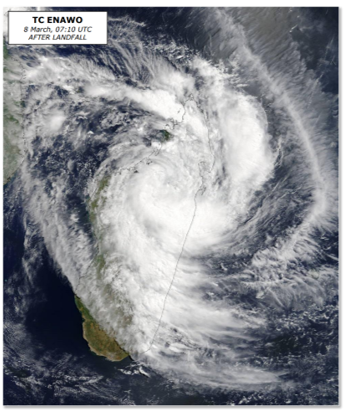
According to a report released by Blaine Gibson and Richard Godfrey, another item has been recovered from a beach in Madagascar, and that part is similar in appearance and discovery location to parts that are from MH370. The new part is believed to have washed ashore in March 2017 and was discovered by a local fisherman at that time, but was unknown to the public until recently.
In a recent blog post that summarizes the finding of the report, Godfrey claims the debris item is likely the remnant of the left main landing gear trunnion door. In this article, we show that we can be very confident that the new debris is NOT a trunnion door.
Misidentification of the New Debris
In a short technical note, MH370 Independent Group (IG) members Mike Exner, Don Thompson, Tom Kenyon, and I show why the new debris cannot be the trunnion door. To determine the approximate size of the trunnion door, we first examine a photo of the underside of a Boeing 777 in which the trunnion door can be seen. Then, using the known wing span of the B777 as a scaling reference, we can determine the approximate dimensions of the trunnion door, which are shown in the figure.

Next, we observe that the trunnion door is attached to the landing gear mechanisms by two brackets, each requiring four fasteners, as shown in this figure. That allows us to determine the position of where we would expect to see through holes through the new debris if indeed it is the trunnion door.

Finally, we compare the debris depicted in Gibson and Godfrey’s report with an outline of the trunnion door, and note that there are no through holes for fasteners in the locations expected. Nor do the dimensions of the new debris match the outline of the trunnion door.

Another piece of evidence that weighs against identification as the trunnion door is the color of the paint, which is white. As Bobby Ulich says in a recent blog comment, the B777s that were operated by Malaysian Air at that time had undersides that were painted grey, not white, as seen in the next photo of 9M-MRO. Although the grey paint might have faded, other debris from MH370 that was previously recovered had identifiable paint such as livery colors and text lettering, so there is only a very small possibility that none of the grey paint would be recognizable.

Cannot Determine Landing Gear Position
There are four parallel, penetrating, narrow cuts on the new debris in which the penetrating objects appear to have entered on the interior surface of the debris and exited from the exterior, white surface. Gibson and Godfrey propose that the cuts could have been caused by rotating engine parts that separated from a disintegrating engine upon impact with the ocean. Whatever the cause of the cuts, the authors believe the damage is consistent with the main landing gear that is lowered based on the direction that the penetrating objects entered and exited the debris.

We’ve already shown that the new debris is not the trunnion door, nor is it any other part of a landing gear door, so it is not possible to surmise the position of the landing gear based on the damage to the new debris. Even if the new debris was part of one of the landing gear doors, there is no reason to believe a rotating engine part caused the damage. Components on one of the shaft assemblies in the engines would tend to fly radially outward from the engine. Yet, the landing gear doors are located aft of the engines, which are positioned forward of the wings, which means the landing gear doors are not along a projectile path. Also, when the landing gear is extended, the exterior surfaces of the doors, not the interior surfaces, are facing the engine.
Lowering the Landing Gear Does Not Increase Damage
Gibson and Godfrey propose that the landing gear might have been lowered to cause a high-speed impact designed to break up the aircraft and sink the aircraft as fast as possible to hide the evidence of the crash. However, this is not consistent with maximizing the kinetic energy of the impact, as lowering the landing gear would add drag, and could limit the attainable airspeed. After fuel exhaustion, the flight control mode would degrade from NORMAL to SECONDARY, and there would be no envelope protection that would prevent an overspeed of the aircraft. The pilot flying would only need to lower the nose by pushing forward on the yoke to ensure the aircraft would shatter upon impact.
Conclusion
The new debris recovered from Madagascar may eventually prove to have probative value. However, the debris is not part of a trunnion door from the main landing gear, nor can the debris provide any insights into the position of the landing gear when the aircraft impacted the ocean. Work continues to identify the debris and to determine any new clues about the disappearance of MH370.
Acknowledgement: This article benefited from discussions with and suggested edits from Mike Exner, Don Thompson, and Tom Kenyon.
Update 1 on February 1, 2023
Based on the construction of the composite layers, Don Thompson, Mike Exner, and other contributors to this blog believe that the new debris is more likely from the racing yacht Vestas Wind rather than from a Boeing 777. Vestas ran aground near Cargados Carajos Shoals in November 2014, and one or more pieces may have separated and floated to Madagascar.
Godfrey refutes this, and now claims that “a closer examination of the recent debris find in Madagascar proves that it is from a Boeing aircraft and cannot be from marine provenance. The key difference is the lightning protection system used on Boeing aircraft with composite materials, which is fundamentally different to the lightning protection system used in marine applications with composite materials. ” Godfrey offers this close-up photo, which he believes shows an aluminum mesh that offered lightning protection for MH370. He believes the mesh was supplied by Dexmet.

Don Thompson refutes the claim that the mesh is related to lightning protection, a dubious claim that was regurgitated by Geoffrey Thomas at airlineratings.com. Don says:
The material highlighted in the photographs referred by the Gibson-Godfrey paper, and ensuing comments from the second author is not an LSP [lightning strike protection] layer; rather, it is a ‘media flow’ layer necessary on the ‘bag’ side of the composite lay-up in a resin-infusion process. That is, the resin-infusion process used by the constructor of the V065 yacht hull, its internal bulkheads and interior decks.
It’s important to understand that an LSP layer will lie immediately under the surface finish on the external face of a panel/structure as any intermediate CFRP (or GFRP) layers will form an (electrical) isolation layer.
Further, the aggregate mix surface coating that is evident in further photographs referred by the second author, and has been argued as somehow typical of B777 panels where surface protection may be necessary, is also evident on decking in video clips that document the rebuild of the seven VO65 yachts ready as they were prepared for the 2017-2018 Volvo Ocean Race. It is a common deck surface coating manufactured by Akzo Nobel/International.
Also, consider the comments from a retired, senior Boeing design engineer whose role afforded him extensive and detailed knowledge of Boeing’s composite fabrication techniques on the B777. For example: that the orientation of CFRP tape tows on the exposed side of the panel is alien to the techniques specified for the B777; that the combination of CFRP fabrication and the panel’s thickness is also alien to a B777’s construction.
The claim that this piece of flotsam originates from 9M-MRO, or any Boeing 777, is demonstrably false. Demonstrably, from the very features evident in the many images shared by the authors of the Dec 12th paper in support of their conclusion for the origin of the piece of flotsam.
The further claim that oceanographic drift studies discount this piece of flotsam originating from the Cargados Carajos Shoals in Nov-Dec 2014 before its alleged recovery from a beach near Antsiraka, Madagascar, is also demonstrably false. That assertion is false because the piece of flotsam did originate its drift, after its separation from ‘Vestas Wind’, at the Cargados Carajos Shoals on Nov 29, 2014, or within the few weeks before the yacht was salvaged and removed. How many times it beached, lay stranded, and washed out to sea again through the cycle of seasonal tides and storms is unknown, as is its final beaching and recovery time, thus rendering drift predictions irrelevant.
So, we now know that the new debris is not part of a trunnion door from the main landing gear, nor can the debris provide any insights into the position of the landing gear when the aircraft impacted the ocean. The new debris is almost certainly not from a Boeing 777, and is very likely from the Team Vestas Wind racing yacht that ran aground in the Cargados Carajos Shoals in November 2014.
Facts are stubborn things.
Update 2 on February 7, 2023
In light of the strong evidence that the new debris is from the Vestas Wind yacht that ran aground in the Cargados Carajos Shoals on November 29, 2014, I thought it would be instructive to study the path of debris that might have broken free of Vestas Wind from the accident.
To study the path of debris, I used the drift results generated by CSIRO’s David Griffin, PhD, that were created for studying how debris from MH370 drifted from hypothetical impact points along the 7th arc. In particular, I used the results of the BRAN2015 model for “generic” debris, i.e., debris that was subjected to “Stoke’s Drift”, modeled as 1.2% of the wind, but with no additional leeway drift. This is appropriate for the floating debris such as the flat panel recovered from Vestas Wind. In CSIRO’s drift simulation, 86,400 “trials” (virtual particles) were injected along the 7th arc on March 8, 2014, and the paths of these particles are tracked. Luckily, 204 of those trials passed within 100 km of the Vestas Wind accident site on November 29, 2014, so the path of those trials after that date should approximate parts of Vestas Wind that separated on that date.
In particular, I studied the timing of debris that beached on the shores of Madagascar, where a trial was classified as beached if there was negligible movement over the course of three days. Of the 204 trials, 61 trials (30%) eventually beached on the Madagascar coast. The following video shows the simulated paths of the debris originating from Vestas Wind:
Based on this simulation, we make the following observations:
- The first debris from Vestas Wind would reach the beaches of Madagascar in February 2015, less than 3 months from the time of the accident.
- Of the debris beaching on Madagascar, more than half would arrive before May 2015, around 5 months from the time of the accident.
- Very few debris would arrive after August 2015, around 9 months from the time of the accident. (The simulation ended on December 29, 2016.)
Any debris that was recovered in 2016 or later likely beached at an earlier time (likely between February and August of 2015), was swept out to sea, and then beached another time at a later date. This is likely what occurred for the new debris described by Gibson and Godfrey.
As Don Thompson noted in a private communication, tropical cyclone Enawo made landfall on Madagascar March 7, 2017, and the storm surge caused major flooding along the coast. The European Commission’s Joint Research Center published an extensive report on the storm, including the damage, as well as the number of people that were injured, missing, or died. A satellite image of the cyclone over Madagascar from that report is show below.

This tropical cyclone likely was responsible for the debris from Vestas Wind beaching on the coast of Madagascar in March 2017.